Columbia ISA
home
– ›
Search
Google
SEARCH Columbia ISA Site
Silver
Your Guide to Buying
About Silver Coins
Gold
Coins
• Gold
Eagle
• Gold
Maple Leaf
• Krugerrand
• How
to test for fake silver coins
Silver
Coins and bars
Silver is one of the basic elements with the chemical symbol Ag from
the Latin argentum. Silver is a precious metal used in jewelry, coins
and many industrial uses. Many nations have used silver as their basic
unit of monetary value. Silver can be alloyed with copper, zinc and
other metals. The U.S. used silver in general circulating coins until
1964 and produced the last circulating silver coin in 1969.
The U.S. Mint issues
a one troy oz. .999 fine silver coin, the silver eagle, with a one
dollar face value. The Royal Canadian Mint issues a one troy oz. .9999
fine silver coin, the silver maple leaf, with a five dollar face value.
Australia, Austria, China, Mexico and Great Britian also mint bullion
silver coins.
Silver has been used as money for centuries. In many languages around
the world, silver and money are the
same word.
Recorded use of silver to prevent infection dates to ancient Greece and
Rome; it was rediscovered in the Middle Ages, when it was used for
several purposes, such as to disinfect water and food during storage,
and also for the treatment of burns and wounds as wound dressing. In
the 19th century, sailors on long ocean voyages would put silver coins
in barrels of water and wine to keep the liquid potable.
The Silver
Market
Precious metals are traded all over the world, from New York and London
to Hong Kong and Shanghai. The silver market is like most, subject to
supply and demand. The supply is limited and requires expensive mining
and refining or recycle of existing silver. The demand comes from
industry, jewelry and investment. The price of silver changes as market
conditions change. This includes many factors including world economic
activity. The price in the USA is expressed in US dollars per
troy ounce.
For
the average silver trader, the spot price is used to value an ounce of
silver. The spot price is the price of silver for immediate delivery
and changes throughout the trading day until the market closes. The
spot price is also influenced by the futures price, that is the price
of silver for delivery months in the future. The current spot price can
be seen at sites like
www.kitco.com
http://www.kitco.com/charts/livesilver.html#ny
From 1990 to 2003, the price of
silver was between $4 to $6 per ounce.
The average silver price in 2003 was $4.85 per ounce. In 2006, the
silver price experienced a 58% increase over the average 2005 price of
$7.31 per ounce. The silver price reached levels not seen in 26 years.
The primary factor driving the stronger silver price was the continued
strength of investment demand. Much of the investment demand can be
attributed to the launch of Barclays’ Global
Investors iShares "Silver Trust" Exchange Traded Fund (ETF), (SLV
sitcker symbol) which was introduced in late April 2006. Silver posted
an average price of $14.67 in 2009. Silver posted an average price of
$20.19 in 2010. In 2011, silver rose to over $45 per ounce before
correcting to around $30 per ounce at years end.
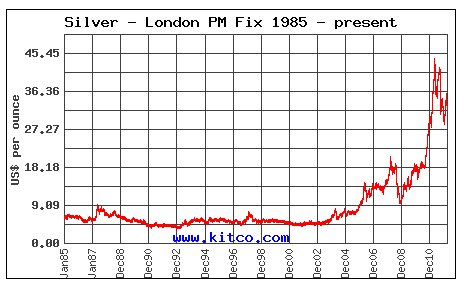
Silver Prices - 1985 to 2012
London Fix
is the price per ounce of
silver set by three market making members of the London Bullion Market
Association at approximately 12:00 noon, London time, on each working
day.

Silver Prices - 2000 to 2012
Buying
Silver Bullion Coins or Bars
When you buy silver bullion coins or bars, you pay the current spot
price plus an extra premium which is the dealers charge for the
transaction. The premium varies dealer to dealer and also from coin to
coin. Bars usually sell for less premium than coins. Part of the
premium is the dealers profit. Silver bullion has no collector value,
so you do not pay extra collector market value for coins. If you are
going to buy a large amount of silver, the premium becomes a concern. A
dealer who charges more than $4 over spot is ripping you off. A good
dealer will usually charge $2.50 to $3.50 over the current spot price
for a one oz. bullion coin such as the silver eagle.
Where you buy silver bullion is very important. You want to buy from a
known dealer so you don't buy a fake coin or bar. All kinds of tricks
are used to fake the metal content. There are hundreds of reliable well
known coin dealers so don't buy from an unknown source. Do some
research online. Check out the dealer before buying. Ask about the
methods to verify the silver coin such as weighing the coin to make
sure it is real.
Rare
Silver Coins
Coins
with a
collector value are referred to as numismatic coins because they are
rare or desirable beyond their silver content. These silver coins are
graded on a scale which identifies the coins quality. The grades have
evolved over time from used and new to grades of good, fine, very fine
up to BU (brilliant uncirculated). The MS description refers to "mint
state" for uncirculated coins and are graded from MS60 to MS70 with
MS70 being a perfect coin.
Professional Coin Grading Service (PCGS) is a third party
authentication and grading service for rare coins.
PCGS was originally started by seven coin dealers in 1985 to
standardize coin grading. PCGS and its competitors play a key role in
rare coin markets as a supplementary quality analysis provider for
collectors in assessing the quality of particular coins. Even small
differences in coin quality can result in dramatic differences in
market pricing. In March 2010 PCGS announced its Secure Plus service,
which digitally takes a unique "fingerprint" of each coin and enters it
into a permanent database.
SILVER
COINS of The United States of America
The Coinage Act of 1792 established the framework for the coins used in
the USA. The U.S. coins for circulation with silver content include
dollar, half-dollar, quarter and dime coins, however, since 1965 with
few exceptions, silver is no longer included in coins in circulation.
Coins today for circulation are copper with nickel exteriors. Only the
silver eagle bullion coin and some proof sets are being minted with
silver content.
MORGAN
SILVER DOLLAR
The Morgan Dollar is one of the most collected silver coins in U.S.
history. First produced in 1878. Both the Morgan and the Peace silver
dollars have an eagle on the reverse side but the Morgan's eagle has
spread wings while the Peace's eagle has folded wings.
Morgan Silver Dollar Coin Minting Information
The largest and heaviest silver coin since the Civil War, the Morgan
silver dollar contains 0.77344 ounces of pure silver. It was minted
continuously from 1878 to 1904 when the government exhausted its supply
of silver bullion. Congress would pass the Pittman Act in 1918,
recalling over 270 million silver dollars for melting and the Morgan
dollar would be minted one last year in 1921 before being replaced by
the Peace Silver Dollar.
Morgan Silver Dollar Coin
Coin Designer: George T. Morgan
| GROSS
WEIGHT |
SILVER
CONTENT |
COMPOSITION |
DIAMETER |
COIN
EDGE |
| 26.73g |
0.77344
oz. |
90%
silver, 10% copper |
38.1mm |
Reeded |
Dates: 1878-1904; 1921
US Mint Branches: Carson City (1878-1893), Denver (1921 only), New
Orleans (1878-1904), Philadelphia (all dates), San Francisco (all
dates)

MORGAN SILVER DOLLAR
PEACE
SILVER DOLLAR
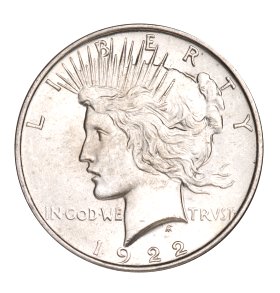
The Peace Dollar was minted to commemorate the signing of the peace
treaty between the United States and Germany at the end of World War I.
All Peace Silver Dollars were struck in high relief in 1921, their
first year of production. The design was slightly modified in 1922 and
normal relief coins were struck later that year. Peace Dollars were
struck continuously until the effects of the Great Depression were felt
in 1929. The U.S. Mint began producing the Peace Dollar again in 1934,
but coins dated 1935 would be the last to see circulation.
Peace Silver Dollar Coin
| GROSS
WEIGHT |
SILVER
CONTENT |
COMPOSITION |
DIAMETER |
COIN
EDGE |
| 26.73g |
0.77344
oz. |
90%
silver, 10% copper |
38.1mm |
Reeded |
Dates: 1921-28, 1934-35
U.S. Mint Branches: Denver (1922-23; 1926-27; 1934), Philadelphia (all
dates), and San Francisco (1922-28; 1934-35)
Coin Designer: Anthony De Francisci
Eisenhower
Dollar
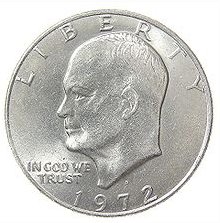
The Eisenhower Dollar followed the Peace Dollar and is named for
General of the Army and President Dwight David Eisenhower, who appears
on the obverse. Both the obverse and the reverse of the coin were
designed by Frank Gasparro. The Eisenhower Dollar is a $1 coin issued
by the United States government from 1971–1978. The
Eisenhower dollar was the last dollar coin to contain a proportional
amount of base metal to lower denominations; it has the same amount of
copper-nickel as two Kennedy half dollars, four Washington Quarters, or
ten Roosevelt dimes. Because of this it was a heavy and somewhat
inconvenient coin. It was often saved as a memento of Eisenhower and
never saw much circulation. This led to its short time in circulation
and its replacement by the smaller, but even less popular, Susan B.
Anthony dollar in 1979.
The Eisenhower Dollar was struck with a copper-nickel composition for
circulation and was the first United States dollar coin to not be
struck in a precious metal, although special collectors' issues were
struck at the San Francisco Mint in a silver-copper composition the
same as the 1965-70 Kennedy half dollar.
Copper-nickel issues:
Weight: 22.68 grams
Composition: Outer Layers of 75% copper, 25% nickel with a center layer
of 100% copper
Silver-copper issues (silver clad):
Weight: 24.59 grams
Composition: Outer layers of 80% silver with a center of 20.9% silver.
Aggregate 60% copper, 40% silver
Silver content: 0.3164 troy ounce (9.841 grams)
Some Eisenhower Dollars were minted in a 40% silver clad to be sold to
collectors. All of these coins were minted at the San Francisco Mint,
with dates 1971, 1972, 1973, 1974, and 1776-1976. Coins minted in 1975
and 1976, all dated 1776-1976 for the Bicentennial, come in packaging
with the similarly dated quarter and half dollar of that brief series.
Walking
Liberty Half Dollar
 
The Walking Liberty Half Dollar is a silver half dollar coin issued by
the United States government, equal to fifty cents. Walking Liberties
were minted from 1916 to 1947. The Walking Liberty half dollar obverse
(front) is considered one of the best designed silver coins in American
coinage. As a result, the obverse design was used for the American
Silver Eagle bullion coin.
Specifications:
Value 0.50 U.S. dollars
Mass 12.50 g
Diameter 30.6 mm
Thickness 1.8 mm
Edge reeded
Composition 90 % Ag
10 % Cu
Years of minting 1916–1921; 1923; 1927–1929;
1933–1947
Each Walking Liberty, as did the Franklin and the Kennedy half-dollar,
contained 0.36169 oz pure silver when minted. A junk silver bag ($1,000
face) of circulated half-dollars weights right at 55 pounds. Because
half-dollars suffered less wear than dimes and quarters, a junk silver
bag ($1,000 face) of half-dollars will net 718-720 ounces of silver if
smelted, whereas a bag of dimes or quarters will net about 715 ounces.
This is one reason half-dollars carry higher premiums than dimes
and
quarters.
Franklin
Half Dollar
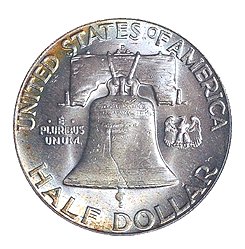
Reverse of Franklin Half Dollar
The Franklin half dollar is a coin struck by the United States Mint
from 1948 to 1963. The fifty-cent piece pictures Founding Father
Benjamin Franklin on the obverse and the Liberty Bell on the reverse. A
small eagle was placed to the right of the bell to fulfill the legal
requirement that half dollars depict the figure of an eagle. Produced
in 90 percent silver with a reeded edge, the coin was struck at the
Philadelphia, Denver, and San Francisco mints. Beginning in 1964 it was
replaced by the Kennedy half dollar.
Specifications:
Value 50 cents (0.50 United States dollars)
Mass 12.50 g (0.40 troy oz)
Diameter 30.61 mm (1.21 in)
Edge reeded
Composition 90% Ag
10% Cu
Years of minting 1948–1963
Kennedy
Half Dollar
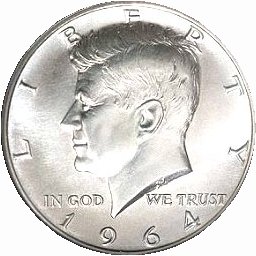 
Starting with 1965-dated pieces, the percentage of fine silver was
reduced from 90% to 40%. In 1971, silver was eliminated entirely from
the coins. Since 2002, Kennedy half dollars have only been struck to
satisfy the demand from collectors, and are available through the Mint.
Value 50 cents (.50 United States dollar)
Mass 11.34 g
Diameter 30.6 mm
Thickness 2.15 mm
Edge reeded
Composition Core: 100% cu
Cladding: 75% cu, 25% ni
Years of minting 1964–present
Washington
Quarter Dollar
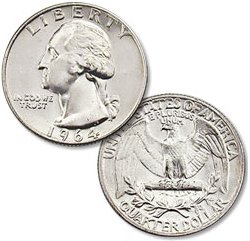
The U.S. quarter dollar is one of the most popular and most used coins
in circulation.
The Washington quarter has been in circulation from
1932 until the present day.
Quarter Dollars
Draped Bust (1796-1807)
Capped Bust (1815-1837)
Seated Liberty (1838-1891)
Barber (1892-1916)
Standing Liberty (1916-1930)
Washington Head (1932-Date)
In 1932 the Washington Quarter made its debut, replacing the former
Standing Liberty Quarter design. A change in metal composition from 90%
silver to 75% copper clad in 25% nickel starting in 1965. Not until
1992-S, in special proof sets, did the 90% silver Washington Quarter
reappear. In 1999 the State quarter reverse design began. Five states
per year were released. But this did not end in 2008 when the last
states were issued. American territories and in 2010, the U.S. national
parks continue the trend.
Non-clad silver quarters weigh 6.25 grams and are composed of 90%
silver, 10% copper, with a total silver weight of .18084 oz pure
silver. They were issued from 1932 through 1964.
1932-1964 and 1992-S to Present (Select Proof Sets Only)
Designer: John Flanagan
Diameter: 24.3 millimeters
Metal Content:
Silver - 90%
Copper - 10%
Weight: 96.6 grains (6.3 grams)
Edge: Reeded
Mint mark: None (for Philadelphia, Pennsylvania) below the wreath on
the reverse
COPPER-NICKEL/COPPER CLAD PLANCHETS (1965-DATE)
Designer: John Flanagan
Diameter: 24.3 millimeters
Metal content:
Outer layers - 75% Copper, 25% Nickel
Center - 100% Copper
Weight: 88 grains (5.7 grams)
Edge: Reeded
Mint mark: None (for Philadelphia, PA) below the wreath on the reverse
1976-S QUARTER DOLLAR - BICENTENNIAL ISSUE -
40% SILVER
Designer: Obverse by John Flanagan; Reverse by Jack L. Ahr
Diameter: 24.3 millimeters
Metal content:
Outer layers - 80% Silver, 20% Copper
Center - 20.9% Silver, 79.1% Copper
Weight: 90 grains (5.7 grams)
Edge: Reeded
Mint mark: "S" (for San Francisco, CA) on the obverse just right of the
ribbon
Roosevelt
Dime

The dime is a coin 10 cents, one tenth of a United States dollar. The
dime is the smallest in diameter and is the thinnest of all U.S. coins
currently minted for circulation. The term dime comes from old French
"disme" meaning "tithe" or "tenth part", from the Latin decima. From
1796 to 1837, dimes were composed of 89.24 percent silver and 10.76
percent copper. With the passage of the Coinage Act of 1965, the dime's
silver content was removed. Dimes from 1965 to the present are composed
of outer layers of 75 percent copper and 25 percent nickel, bonded to a
pure copper core.
Draped Bust 1796–1807
Capped Bust 1809–1837
Seated Liberty 1837–1891
Barber 1892–1916
Winged Liberty Head (Mercury) 1916–1945
Roosevelt 1946–present
Starting in 1992, the U.S. Mint reintroduced silver coins in its annual
collectors sets. This included a 90 percent silver proof Roosevelt
Dime, Washington Quarter(s) and Kennedy Half Dollar, a series that
continues today.
Junk
Silver
Until 1965, U.S. coins, dimes, quarters, half-dollars, were made of 90%
silver. 1964 was the last year that coins were made of 90% silver and
10% copper. These pre-1965 coins are often referred to as "Junk
Silver". You can buy these coins in a "bag" which contains a specified
amount of face value silver coins and can be a mixture of dimes,
quarters and half dollars all containing 90% silver. A "bag" in the
common usage refers to $1000 face value in silver coins. These bags do
NOT sell for $1000 but for the value of the silver.
How
to calculate the
value of Junk Silver
A typical $1000 face value bag contains about 715 ounces of silver. If
you know the current price of silver, you can multiply it by 715 to get
the silver value of a $1000 bag. (The silver market goes up and down
over time hitting highs and lows. In 2011 silver prices have been going
up and up. In July 2011 for example, spot silver was rising above $40
per oz.)
For this example we will use $28 per oz.
715 * $28 = $20,020 for example.
This is for $1000, so $1 in silver coins is worth 1/1000 of this amount
which is $20.
Dimes come in rolls of 50 with a $5 face value, each $5 roll would be
worth $100.
Quarters come in rolls of 40 with a $10 face value, each $10 roll would
be worth $200.
You can purchase rolls or bags of silver coins and if you check the
current silver price and use these calculations you can determine what
the value is.
Another example: $1000 face value bag of all quarters = 4,000 quarters
at 0.18084 oz. of silver = 723 oz. at $28 per oz. = $20,254.
Half bag $500 face 358 oz., quarter bag $250 face 179 oz., and tenth
bag $100 face 72 oz. are also available and you can buy coin by coin.
If you want 133 quarters for example, a dealer can count out any value
you want.
• Silver
content of U.S. coins
Silver
Bullion - Coins and Bars
Bullion has no collector value. You just pay for the silver content.
Silver bullion coins, bars and rounds are available. The U.S. Mint
produces each year the American Silver Eagle bullion coin, a 1 troy oz.
coin of .999 fine silver with a face value of one dollar.
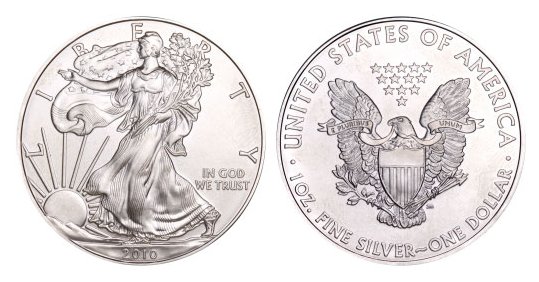
The Silver Eagle dollar was first released by the U.S. Mint on November
24, 1986. It contains one troy ounce of .999 Pure Silver, and has a
nominal Face Value of One Dollar. Its weight and content is certified
by the U.S. Mint. For coin collectors, the U.S. Mint produces a proof
version of the coin. The Silver Eagle dollar has been produced at three
minting locations, including Philadelphia (‘P’
mintmark), San Francisco (‘S’ mintmark) which
issued proofs, and more recent proofs from West Point.
An authentic Silver Eagle dollar will weigh at least 31.103 grams, and
its diameter is 40.60 mm, with a thickness of 2.98 mm. Its edge must be
reeded, and the Silver content is 99.9%. The obverse design features
walking Liberty and is adapted from the design of Adolph A. Weinman
during the year 1916. The reverse design features a Heraldic Eagle with
Shield, 13 stars, and United States of America on top, which was
designed by John Mercanti in 1986.
The U.S. Mint sells Silver Eagles in "tubes" 20 coins per tube and
"monster" boxes of 25 tubes (500 coins). One tube (20 coins) of silver
eagles should weigh roughly 670 grams give or take a few grams
depending on the tube's weight and the slight variations in the coins
weight.
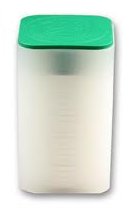
Silver Eagle tube of 20 coins from the U.S. Mint
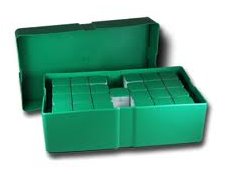
Silver Eagle Monster Box of 25 tubes at 20 coins each totals 500 coins
(500 oz.)
Mintages of Silver Eagles has been from about 4 million to 10 million
per year from 1986 until 2007, with 1996 being the lowest at 3.6
million, but starting in 2008, mintages have increased dramatically to
20 million, then 29 million in 2009 and almost 35 million in 2010. In
2011 39,868,500
silver eagles, just under 40
million, were sold according to the U.S. Mint.
CANADA Silver Bullion
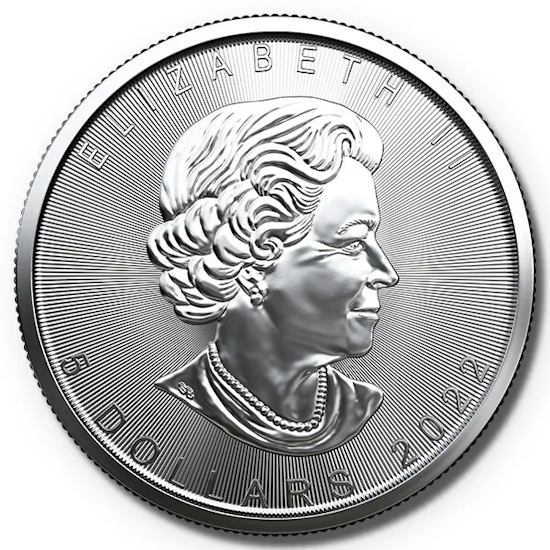

The Royal Canadian Mint issues a silver bullion coin, the silver maple
leaf. In 1988, the Mint introduced a Silver Maple Leaf Series that would hold a $5 CAD legal tender and
contain one troy ounce of .9999 silver. The coin comes in tubes of 25 coins. The
Monster box of silver maple leafs is like the USA version only with 20
tubes in yellow instead of green. So you still get 500 coins (500 oz.)
Three different profiles of Queen Elizabeth II have appeared on the series over the course of its issuance. The Sugar Maple Leaf
design has not been significantly changed since its debut, however, the Mint has added security features over the years
that alter the coins appearance, while ensuring its authenticity.
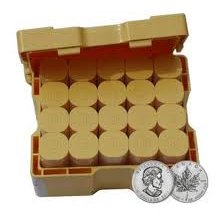
Canadian Monster Box of silver maple leafs
Silver
Bars
Bars are an alternative to coins. Bars are typically available in 1
oz., 10 oz., and 100 oz. .999 fine silver. Bars of silver are produced
by refiners and bear the name of the refiner. Reputable refiners
include Engelhard, Johnson Matthey, Pan American Silver Corp.,
Westminster Mint, Sunshine Mint, Northwest Territorial Mint, and
A-Mark. The public demand for physical silver product started in the
early 1970s. By the mid to late-1970s, Johnson Matthey and Engelhard
dominated the market.
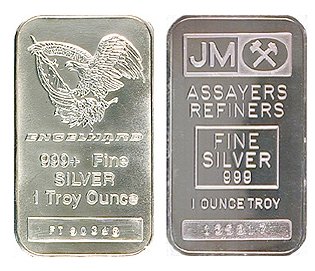
Engelhard and Johnson Matthey silver bars
 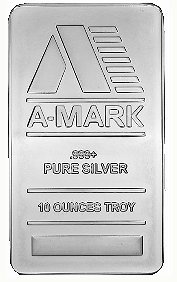
Sunshine Mint ten oz. silver bar and A-Mark ten oz. silver bar
The premium over spot silver is slightly lower for 1-oz silver bars
than for 1-oz silver coins (Canadian Maple leaf silver coins or
American Silver Eagle coins) or for 1-oz silver rounds like Engelhard
Prospectors. You can buy 1-oz silver bars on Ebay, Amazon or from
online precious metals dealers. Also COMEX, APMEX and MONEX.
Silver bullion bars are a popular way to buy silver. Engelhard silver
bullion products are the best-known brand in the industry. Engelhard
was one of the world’s largest refiners of precious metals
before being purchased by BASF in 1986. Since these bars have not been
issued since the 1980’s the only way to buy them is in the
secondary market. Each bar is hallmarked stamped for weight and purity.
Silver
Rounds
Silver rounds contain one ounce of .999 fine (99.9% pure) silver. Among
the most popular and well-known 1-oz silver rounds presently being
minted are those carrying the names of Sunshine Minting and A-Mark
Precious Metals. Other 1oz silver rounds, but without the mints' names,
are the Buffalo/Indian Head silver rounds and the Standing Liberty
silver rounds.
Sunshine silver rounds are popular because they are usually readily
available, and the name Sunshine is nearly synomomous with silver
because of the famed Sunshine silver mine in Coeur d'Alene, Idaho.
Sunshine silver rounds are sometimes called silver eagle rounds because
the front depicts an eagle flying through the sun. However, in the
silver bullion community, the term Silver Eagles is reserved for the
U.S. Mint's American Eagle silver coins.
A-mark silver rounds have been manufactured since 1983 and sometimes
show up in the secondary market. However, most A-mark silver rounds now
available are new, 20 coins to a tube. A-mark silver rounds carry an
image of the Liberty Bell on one side and an image of an eagle on the
other. They are clearly marked 1-oz .999 silver.
Buffalo silver rounds
Buffalo/Indian Head silver rounds are relatively new but are widely
accepted because of their design: the legendary U.S. Buffalo/Indian
Head nickel, which was minted 1913-1937. Across the top on the back is
UNITED STATES OF AMERICA. However, the coins are privately-minted.
Standing Liberty silver rounds
The classic Augustus Saint-Gaudens' Standing Liberty, which graces the
beautiful $20 Double Eagle gold coins (1908-1933) known as the
Saint-Gaudens, stands proudly on the Standing Liberty silver rounds.
The reverse carries an image of a magnificent gold eagle.
Generic silver rounds
Generic silver rounds refers to 1-oz .999 silver rounds that generally
are not identified by their names. With the silver bullion industry now
in its fourth decade, many silver rounds fall into the category of
generic silver rounds.
Engelhard Prospector silver rounds
From 1975 to 1988, Engelhard produced 1-oz Prospector silver rounds.
The Prospector silver rounds were so named because the obverse of the
round bears the image of a prospector panning for gold. Because of
their high quality and the name Engelhard, Prospector silver rounds
have remained extremely popular with silver investors. Engelhard
Prospectors are no longer made and are available only when investors
sell into the secondary market, which is not often. When Prospector
silver rounds are available at only slightly higher prices than other
silver rounds, buy them.
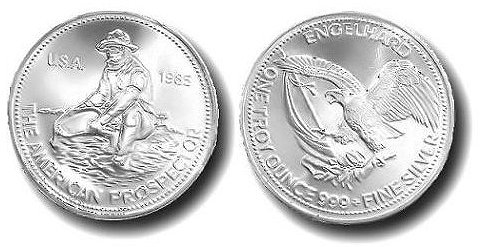
The Engelhard Prospector Silver Round
Johnson Matthey silver rounds
In the mid-1980s, Johnson Matthey, a company in the precious metals
industry as respected as Engelhard, minted Freedom Rounds, so named
because they celebrated the first ten amendments to the U.S.
Constitution, known to all Americans as the Bill of Rights. Freedom
silver rounds are excellent pieces and should be acquired when
available; however, few were made, and they rarely show up in the
secondary market. Johnson Matthey Freedom silver rounds and Engelhard
Prospector silver rounds carry about the same premiums.
When originally manufactured, Johnson Matthey Freedom silver rounds
came in Mylar sheets of twenty. When they show up in the secondary
market, sometimes they are still in the original Mylar packaging.
Question:
What percent of my net worth should I invest in precious metals?
Answer:
That depends on several factors. Every person is different and is in a
different situation. If you are young, you have a different perspective
than an older person. Your goals could be very different from someone
else's goals. Regardless, nobody knows for sure what is going to happen
to the world economy in the future. Diversification is the key. By
having a stake in many areas you should not lose out big if one area
falls. Have some stocks, have some real assets, have some cash, have
barter items and have some precious metals. With this thinking,
generally speaking about 15% in precious metals is a good guideline.
Patience is a large part of your strategy. Little moves over time is
better than rash plunges all at once. Remember information is power.
The more you know about an area the better decisions you can make.
• Silver
Coins International
• Gold
Coins and jewelry
• Gold
Eagle
• Gold
Maple Leaf
• Krugerrand
• Diamonds
Buying Guide
• Diamond
Rings
• How
to tell if a Diamond is real
• What
is moissanite?
• How
to read a diamond certificate
Bullion
Dealers and Coin Links
Provident Metals
• Provident
Metals
Gold, Silver, Platinum, Copper, Palladium, U.S. and foreign coins
Order by phone 877-429-8790
Provident
PO Box 325
Lavon, TX 75166
sales@providentmetals.com
• Omega
Precious Metals, Inc.
18 Village Square Glen Cove, New York 11542
1-800-474-6960 or 516-759-6960 Fax: 516-759-6979
Email: JoeHylas@AllCoins.US
• OnlyGold
CSG Inc. 4216 West Dunlap Avenue, Phoenix AZ 85051-3654
1-800-800-4485
• Certified
Coin Exchange
• Wexford Coin
Wexford Capital Management
David W. Young, President
113 Brenton Court
Stephens City, Virginia 22655-4819
(877) 855-9760
Fax (866) 611-3526
• Tulving
• Gold coins
bullion
• Encore gold
Encore Gold, LLC
307 Division Street
Northfield, MN 55057
(877) 563-8736
• Fort
Worth Coin
• Gold central
• Goldline
• Coin maven
• Coins
plus
• Gold
coins
• MJPM
• USA
Gold
• AJPM
• Amerigold
• APMEX
• Austin Coins
• Blanchard
• Coin
guy
• Gold dealer
• Camco coin
• Certified
gold exchange
• Certified Mint
• Goldmasters USA
• Coin guide
• Precious metals
• Jack
Hunt Kenmore N.Y. 14217
(800)877-7424
• JT Coins
• Louisiana gold
• Merit Financial
• The
US Mint - Current Mint Issues
• US Bureau of
Engraving - Currency for the Collector
PCGS - Professional Coin Grading Service
NGC - Numismatic Guarantee Corporation
ANACS - American Numismatic Authentification Certification Service
I.C.T.A. - Industry Council for Tangible Assets
• World
Gold Council
|
|
|